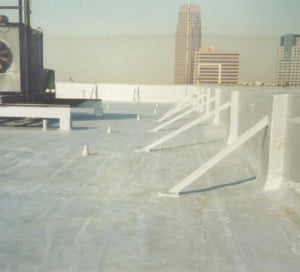Liquid roofing systems forgo traditional shingle or tile roofing and instead use a waterproof membrane to 

Flexibility
One advantage liquid roofing has over conventional roofing is its overall flexibility. Roof liquid waterproofing products can be used on commercial buildings or private homes, adhere to virtually any material, and seal around any HVAC unit, vent, or other common problem areas for traditional roofing systems.
Economical
Liquid roofing systems are much cheaper to install than shingle roofs. Factoring in labor costs, removal of the old liquid roofing, materials, equipment, and supplies, a shingle roof can be a timely and costly undertaking. Other roofing systems can suffer from bumps, overlaps, and uneven spots which lead to water pooling, a tremendous threat to your waterproofing efforts. A properly installed liquid roofing system does not suffer from these issues as the coating alone performs all the functions needed to comprise a stable, waterproof roof.
Liquid roofing products are easy and cheap to install and require less prep time. SANI-TRED can be painted, rolled, or sprayed on a properly prepared roof in a fraction of the time it takes contractors to install shingles or tile.
Liquid roofs require less maintenance. Shingle or tile roofs often need yearly maintenance, occasional replacement, and sometimes costly repairs. Liquid roofing systems require little upkeep, rarely need repairs, and any repairs are still cheaper than hiring a contractor to replace shingles or tiles.
Functional
A liquid roofing system not only provides better protection for the building, but also extends the life of the roof. A properly installed liquid roof is a seamless, monolithic membrane that provides better waterproofing than other types of roofing. SANI-TRED can adhere to virtually any substrate, making it a great product to seal and waterproof a liquid roof system. In addition to its superior waterproofing, a liquid roof also seals around HVAC units, vents, downspouts, and other roofing elements that can prove troublesome for other types of roofing. In addition to its superior waterproofing abilities, SANI-TRED can also prevent rusting and increase the lifespan of caulking and sealants, protecting the overall health of the roof.
Green
Liquid roofs are also better for the environment. Installing a new shingle or tile roof requires intensive labor and higher costs, but also removing the old roofing in able to replace it. This old roofing has to be properly disposed of and old shingles eventually end up in landfills, becoming more pollution. And that’s not even counting the costs associated with dumpster rental and landfill fees. A liquid roofing system doesn’t require the removal of the old roof, it seals on top of the old roof, saving you time and money while producing none of the waste associated with shingle or tile roofing.
In addition, SANI-TRED contains Low VOCs, which means it will produce less waste and the material itself is environmentally-safe. A liquid roof has also been shown to lower energy consumption, making your building more energy-efficient and relying less on air conditioning or heating which contribute to air pollution.
Sustainable
One of the key advantages of using liquid roofing products is sustainability. A liquid roof lasts longer than other types of roofing, often requiring little maintenance and fewer repairs. SANI-TRED will not crack, peel, or delaminate and will protect your roof from weathering. A liquid roof has many advantages and is a viable alternative to traditional shingle or tile roofs. For more information on liquid roofs, please consult the following links.

